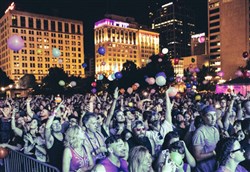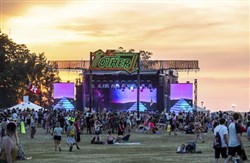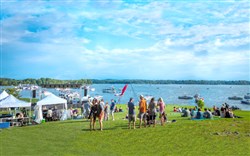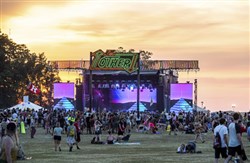VOL. 43 | NO. 31 | Friday, August 2, 2019
Sound investment?
By Hollie Deese
The founders of Nashville’s Live on the Green music festival weren’t sure what to expect. It was 2009, their first year, and startup festivals are a risky, expensive venture that can either be a talked-about triumph or a practically ignored footnote in any given summer’s agenda.
“We were nervous no one was going to show up, so when we had a couple thousand people show up the first night we thought, this is amazing,” says Gary Kraen, vice president of operations and programming for radio station Lightning 100 and the producer of Live on the Green music festival.
Continued success in the music festival business – whether it’s a local grassroots event like Live on the Green, the blockbuster of Bonnaroo or Knoxville’s innovative Big Ears festival – is unpredictable, and it’s far more than fear no one will turn up.
There are financial factors about cash flow and credit, fundraising considerations, community and public relationships, partnerships and sponsorships, deciding whether to have a paid or free event, the need to land that big-name act year after year, and even dealing with a community when an event overwhelms the city.
Music festivals can add to the character and reputation of a community, increase sales tax revenue and boost local nonprofits.
And, when the event works, it can be magic, even if it takes a few years to attract the attention of the audience and the arts.
Along with Kraen, Live on the Green was founded by Tom Hansen and Laurel Creech, both then at Lightning 100, the station’s owner Lester Turner Jr., and Chris Cobb of Exit/In. All are still involved except Creech, and Chris Paxton has since joined the team as festival director.
Live on the Green’s organizers were one of the first groups to use Public Square Park for a music festival, and their success has helped usher other events to the space. And back then everything took place on the green too, even all of the vendor setup. But over the past 11 years as the festival has grown the vendors moved off the green and now their footprint has expanded several blocks.
“I think after about the sixth year of Live On The Green we could sort of prove that we were going to be around and that it was a worthwhile event for people to be a part of,” Kraen says. “But this year it seems like it’s going really well for vendors. The last couple of years I think there was a waiting list. And it’s only been in the last five or six years that we had all these food trucks, so that whole business has evolved.”
Attendance has grown, too, from 18,000 total attendees the first year to more than 100,000 attendees over the six nights last year. In all over the past 10 years more than 600,000 fans from all 50 states and 15 countries have attended the event.
But the festival founders still feel the pressure to remain relevant as more and more festivals compete locally, like Williamson County’s Pilgrimage Festival, which launched in 2015 with big headliners like Wilco and Willie Nelson, and backed by pop superstar Justin Timberlake.
Tickets for Pilgrimage this year, with headliners like Keith Urban and the Foo Fighters, range from $130 for a single day ticket (parking an additional $70) to a $2,500, two-day Blackberry Farm package.
And it’s that cost that almost works against the free Live on the Green.
“We have lots of competition, and it’s very difficult to compete with people that have a paid ticket because ours is free,” he explains. “So we’re counting on sponsorships and any concessions, plus just being funded by Lightning 100. Which is our promotional expenditure for the year but it’s an expensive venture.”

Attendance at Live at the Green has grown to more than 100,000 patrons over its six night run last year.
-- Photograph Courtesy Of Live On The GreenAs a promotional arm for the radio station, the festival works because many people actually discover the radio station because of Live On The Green – people Kraen says never even expected to want to listen to a radio station. Every act they book is the same kind of artist they play on the radio station in addition to a large local initiative cross promoting festival acts on air.
“Twenty-five percent of our programming on Lightning 100 is local. And so, we have four nights this year of local stages. It’s not about making money,” he adds. “It’s really about serving Nashville and being an extension of Lightning 100.”
Kraen notes there may come a time when there will be a charge for something, if only to compete with the many other festivals in booking talent. While paid VIP packages are available, the goal is to keep it free like it has always been.
“When I have to go to an artist and offer a lot less than someone down the street, or the next major city two hours away, it’s difficult,” he continues.
But having the Lightning 100 brand behind the festival helps almost as much in booking acts as money does, thanks to the longstanding relationships he and his coworkers have built with labels and booking agents. It’s a win-win situation for the acts as well.
“There are artists that we may get on the stage that are going to have maybe 20,000 people in front of them - 10,000 won’t even know who they are, so it’s a great opportunity for them to gain new fans,” Kraen says.
Artist booking and production costs like stage construction and lighting are the biggest expenses, Kraen adds. The large footprint of tents for vendors is a big expense too, along with stage and lighting.
“I think every moment we go into it thinking, how much longer can we do this? And then once the first night happens, everybody’s so giddy and excited, it’s like everybody just flies high for the next few weeks. It’s such a labor of love for everybody,” Kraen says.
It’s that commitment from the staff year after year that is part of what has made Live on the Green the respected festival it is now. Simply by showing up and having the festival every year they have proven they have longevity which helps a lot when booking acts.
“We’ve certainly got the attention of the entertainment world,” he says. “We’ve gotten the attention of other festivals. Live On The Green is a respected festival now, which helps in getting name talent. They want to be part of a radio station event even though they may not make as much money as they would at Bonnaroo or some paid festival.”
And while the lineup might be killer every year, all Kraen can think about is the artists they couldn’t get. “But then nobody knows who you didn’t get. They just see who you got. And I think everybody seems to be happy about it. Which I’m happy about.”
Big Ears, big growth
Kim Bumpas, president of Visit Knoxville, says that over the past five years festivals have grown substantially in the area – not simply with the addition of new ones, but also growth in the visitor experience with the quality of the festivals, new and existing, always improving and adding to the market.
“I will definitely say, though, that all of these festivals have made Visit Knoxville’s job a lot easier because they add not only a visitor experience, something to do when conventions and sporting events are in town, but they also have started to bring people to town.
“Big Ears is a great festival,” Bumpas says. “It tells the story around the world of why you should visit Knoxville, which is also extremely important. And an awesome way to tell the story.”
The Big Ears Festival launched in 2009 but ended after one year on the basis of a scheduling conflict, returning to downtown in 2014.
Created by Ashley Capps, founder of AC Entertainment, Big Ears was originally organized by Capps in partnership with Jason Boardman of Knoxville’s Pilot Light and Chris Molinski of the Knoxville Museum of Art.

Spiritualized performs at the Mill & Mine on Day 2 of this yea's Big Ears Festival in Knoxville.
-- Photograph By Eli Johnson PhotographyAC Entertainment is the co-producer of Bonnaroo. They founded the festival with Superfly Entertainment. Earlier this year Superfly sold their stake in Bonnaroo to Live Nation. AC Entertainment also produces the WayHome festival in Barrie, Ontario, the Forecastle Festival in Louisville and the Mountain Oasis Electronic Music Summit in Asheville.
Big Ears incorporated as a nonprofit in 2016. Ticket revenue accounts for about half of the cost to present each year’s festival, so donors and sponsors make up the rest as the festivals continue to expand. It is a move straight from Bonnaroo’s playbook. In 2009 the Bonnaroo Works Fund was launched, which claims a portion of the proceeds from ticket sales.
At the end of each fundraising cycle, the BWF board distributes grants through an online application process to nonprofits with Tennessee-based arts, education and sustainability initiatives.
According to Billboard, since 2002, Bonnaroo’s organizers have donated over $7 million to a wide range of causes, including Habitat for Humanity and the Country Music Hall of Fame and Museum.
So sometimes you have to take the pros and the cons – because a weekend of increased traffic and more people can have an impact on the community that goes beyond the festival.
“I’m passionate for tourism, it’s my job, but I think as a resident you have to somewhat put those inconveniences to the side, and see the greater good of what these events do, which is expose the destination to people that may not have known about it,” Bumpas adds. “They enhance repeat visitation. They can even encourage new visitation.”
Bumpas says the sales tax generated by people attending festivals, and not just hotel and motel tax which goes back into marketing, make it very important that events like Big Ears festival exist.
“All of that money comes back into our destination, that we can then turn around and use to make our roads better, or enhance our schools,” Bumpas says.
Gallatin gives it a try
On August 3 Gallatin will host its second Fire on the Water Festival, a one-day music and arts festival on Old Hickory Lake, an event which Gallatin Mayor Paige Brown says is aimed at showcasing the city as much as the entertainment.
“The motivation for the city of Gallatin was to bring people to our community,” Brown explains.
“For a long time we were trying to attract people to our area to live and to be interested in making our community their home, but now that’s not the case anymore. We want to bring people to Gallatin for other reasons. We want them to come here and enjoy our natural beauty and our shops and our restaurants.”
Brown says there were certainly hurdles to conquer last year, their first year, but the fact the festival has returned for a second year will only bolster confidence for sponsorships moving forward.
“I think people tend to wait on proof of performance and feedback from people, and we were delighted that we just got outstanding feedback all the way around,” Brown notes. “The things that were suggestions for improvement were so small and things we are actually able to improve upon this year.”
One suggestion was the walking length of the distance into the park, so they are adding more shuttles. More lighting at night will also be added.
One thing the organizers haven’t conquered yet is a way for people to come to shore from the water. The city has applied for a grant for a dock but that would not happen in time for this year’s event.
“We’ve already seen evidence that just being a repeat festival has power, because you’re such an unknown that first year out, and I get that,” Brown says. “That’s a huge reason that we’re doing it again because a lot of people don’t want to be the first time at something.”

Gallatin's annual Fire on the Water Festival brings multiple musical acts to Lock Four on Old Hickory Lake, 25 miles from Nashville.
-- Photograph Courtesy Of Fire On The WaterJeff Hentschel, communications director for the city of Gallatin, estimates 100 boats attended the festival from the lake last year while another 1,500 people attended at Lock 4 Park. He says they have doubled the amount of tickets sold at this time last year, and their Facebook numbers have improved with more than 32,000 interested and 8,000 visits to the festival’s website.
The sales goal is 3,500-4,500 tickets with proceeds benefitting the park.
“This has everything to do with the bands in our lineup this year,” Hentschel wrote in an email. “As we were booking the bands, the agents began to comment that their artists wanted in because the lineup was so solid. That’s when we knew this was the year for Fire on the Water.”
Last year the total cost of the festival was $100,000. After all expenses and revenue the festival lost $40,000.
“It’s not ever going to be a Pilgrimage or Bonnaroo,” Brown says. “It’s going to be a small festival, and it’s never going to make a lot of money for the city. It’s going to cover our costs, and it’s going to bring us positive attention, and it’s going to expose new people each year to Gallatin.”
Brown says some of the consequences of the festival have been musicians coming to the area to film music videos and a recent Free Fishing Day at Lock 4 Park with WSM radio and Gallatin Parks Recreation, sponsored by Academy Sports, with 10 artists performing on stage.
“We feel like that was a direct result of that event, and that’s exciting,” Brown says.
A festival for everyone
Millions of music fans worldwide look forward to the summer season because of all the festivals, an opportunity to have fun and see a lot of different music all at once. Festivals also give musicians the opportunity to win over new fans who may not have attended their own concert otherwise.
“Music festivals and festivals of all kinds, really, bring people together to celebrate one thing–whatever it is,” says Maria Ivey of IVPR, a local public relations firm representing artists and festivals.
“Food, music, art, dance, you name it, there’s probably an event or festival centered around it,’’ she says. “I love looking out from the stage at festival and seeing all types of people from all walks of life enjoying the same thing. It’s unifying. Whether we are bonding over food or music or art – it doesn’t matter. Festivals, and especially music festivals, are one of the rare times that people drop their bias, their political views, their opinions and just enjoy.
“Together. That is powerful.”
Ivey is a Nashville-native with more than a decade of experience in artist and festival PR. She is also the co-author of “Music Publicity: A Practical Approach,” a textbook to be published by Kendall Hunt later this year 2019. She is a guest-lecturer at her alma mater, Belmont University, and has moderated and presented on PR panels at AmericanaFest, Folk Alliance International, and IBMA, the association of bluegrass music.
“It was a natural progression for our firm,” Ivey says of focusing so strongly on festivals. “As an artist publicist, I certainly appreciate having on-site media opps for our artists to maximize their festival play – whether that be a video session or a radio interview. We are always looking for ways to capitalize on whatever our client has going on career-wise.”
Ivey remembers a conversation in the interview process for her first festival client in which she explained what artist publicists value in festival media, and that taking the artists into consideration, both their time and their strengths, is key, but so is understanding the need brands have to connect to the festival audience.

Bonnaroo, the annual music festival in Manchester, Tennessee, has become a highly successful venture with world-renown acts and huge audiences.
-- Photo Courtesy Of Amy Harrison/Invision/Ap“It’s mutually beneficial for both festival and talent,” Ivey says. “My team is always asking ‘what makes this festival unique?’ Sometimes the story comes from the festival’s beginnings – why it was started in the first place – and sometimes it comes from the growth of an event, how a community has rallied around it. The options are endless.
“Festival PR is where we get to be really creative in our pitches and approach.”
Festivals raise funds
Ivey adds many of her clients have a charitable component – one even operates solely as a fundraiser for a community college in a small town.
“Every year, the economic impact report shows that the festival makes up a large portion of local businesses revenue,’’ she continues.
“All of our festivals have a non-profit arm and each does something very specific. Some are centered around the local community where the festival is held. Food drives, supporting music in the schools, and so on. It’s great to be able to give back and when large groups of people come together, the sum of your resources naturally increases. It’s beautiful.”
Cash flow and credit
Mark Ford is the vice president of the music industry group at First Tennessee Bank. Ford had previously worked at Suntrust Bank in their sports and entertainment division on Music Row. In August 2016 First Tennessee recruited him to start a music industry group. Today they work with music industry companies, publishers, labels, festivals, production companies – basically anything with ties to the music industry.
“They’re a very cash intensive business, so they require a good bank, and a good bank that understands their business cycles,” Ford says. “It’s always been a pretty big part of our business, whether it be on the just the deposit account side or treasury type work, taking credit card payments, or even just financing them and lending them money on future festivals, or making an artist advance, or something along those lines.”
He agrees that successful festivals have a charitable arm to what they do. He has even donated to a cause himself after he got fired up while learning about them through a booth at a festival.
“Most of the festivals these days do have a not-for-profit component to it, a foundation they’re supporting, or cause they’re trying to help raise (funds),” he says. “It’s a big thing. I’ve seen a lot of money raised for not-for-profits through festivals, from just the attendees there.”
But operating a festival is risky financial business, and many of them need help with their cashflow cycles, bridging when they need cash to make an advance to an artist – many of whom are increasingly demanding payment up front due to the number of festivals that can’t survive.
“They trust the credit worthiness of a festival and have had enough of them fall apart, and people not get paid that they want their money up front now,” Ford says. “That’s called accelerating the cashflow cycle for a festival, so they’ve got to have the money sooner than what they used to need it.”
But to get that kind of help from a bank, it really has got to be a long-established festival. And that makes it even harder for new festivals to gain their footing.
“We’re not going to be taking that kind of risk for some type of startup festival,” Ford acknowledges. “We’re not taking those type of risks. We’re working with the people that have been going on for 10, 20 years, things of that nature. We don’t take any startup risk, or new festival risk.”
Ford says the financial risk for a startup festival – which will typically lose money the first few years at least– is getting the crowd to continue to grow to eventually turn profitable.
“That’s your primary risk is, just getting the people to come and keep coming back,” Ford says.
And it’s something that is more and more difficult with growing market saturation issues. Twenty years ago there just were not that many options for going to music festivals. Now, almost every city has multiple options.
“As the number of them have grown they’re just all taking business from each other,” Ford says.
Too much, maybe?
Liz Jeneault is Faveable.com’s vice president of marketing and a former news anchor who worked in Austin for three years, home to the massive South by Southwest music and film festival.
She says music festivals are a great benefit to the communities they are in, even if the community hates the crowds while they are there. And proof of that lies with the Austin City Limits Music Festival, a huge event that takes over Zilker Park for two weekends.
“While residents are unable to use their beloved park as they normally can while the festival is going on, the event greatly benefits the city in other ways,” Jeneault says. “A portion of every ticket sale and other revenues from the festival goes directly to supporting Austin’s green spaces.
“Fans have contributed $35 million to Austin’s parks. Several projects have been completed as a result, including the redevelopment of Republic Square downtown. The festival also brings in a rush of customers for local businesses, which always appreciate the support.”
Ford says the festival operators they do business with are very much aware of being good partners with cities and municipalities, and making sure it’s a good thing for all parties involved. In today’s climate there is just no other way.
“The city, the politics and the partnerships are probably more important now than ever,” Ford says. “You have to make sure you’re doing good things for the city, and it’s worth it to the city or the municipalities that you are interrupting. Is it worth it to a city like a Manchester, to create mass chaos for a weekend for its residents? I guess it depends on what viewpoint you’re looking at it from.”